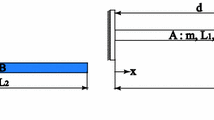Abstract
A computation model based on inverse receptance coupling method is presented in this paper aiming for obtaining the joint interface’s stiffness and damping properties using frequency response functions measured on assembled structures only. In the model, it is emphasized that the joint stiffness and damping should be modeled with frequency dependency. The model’s validity is checked both through finite element (FE) simulation and experimental analyses. In the FE simulation example, the computation model gives more accurate results with noise-free data. In the experimental example, where noise in the data is unavoidable, the computation model is explored further for its applicability in the real industrial environment. Results from applications of the computational model show that it is even capable of obtaining the joint interface stiffness and damping values over the structure’s resonance frequency. A viable process of predicting behaviors of workpiece with receptance coupling method through identifying the joint interface properties is presented in the end of the paper. The applicability of this computation model and the factors that influence the accuracy of the model are discussed in the end of the paper.
Similar content being viewed by others
References
Stephenson DA, Agapiou JS (2006) Metal cutting theory and practice. CRC Taylor & Francis, Boca Raton
Bograd S, Reuss P, Schmidt A, Gaul L, Mayer M (2011) Modeling the dynamics of mechanical joints. Mech Syst Signal Process 25:2801–2826
Tsai JS, Chou YF (1988) The identification of dynamic characteristics of a single bolt joint. J Sound Vib 125:487–582
Wang JH, Liou CM (1989) Identification of structural joints by use of noise-contaminated FRFs. J Sound Vib 261–277
Ren Y, Beards CF (1995) Identification of joint properties of a structure using FRF data. J Sound Vib 186:567–587
Wang JH, Yang MJ (1999) “Problems and solutions in identification of the parameters of mechanical joints, inverse problems in engineering: theory and practice,” presented at the 3rd Intl. Conference on Inverse Problems in Engineering port Ludlow, WA, USA
Rashid A (2005) On passive and active control of machining system dynamics: analysis and implementation. Doctor Monograph, Production Engineering, KTH, Stockholm
Liu W (2001) Structural dynamic analysis and testing of coupled structures. University of London
Čelič D, Boltežar M (2008) Identification of the dynamic properties of joints using frequency response functions. J Sound Vib 317:158–174
Wang M, Wang D, Zheng G (2012) Joint dynamic properties identification with partially measured frequency response function. Mech Syst Signal Process 27:499–512
Yang KT, Park YS (1993) Joint structural parameter identification using a subset of frequency response function measurements. Mech Syst Signal Process 7:509–530
Sajed Sadati SM, Nobari AS, Naraghi T (2012) Identification of a nonlinear joint in an elastic structure using optimum equivalent linear frequency response function. Acta Mech 223:1507–1516
Sadeghi MH, Soleimanian P, Samandari H (2012) “Model updating of complex assembly structures based on substructures-joint parameters,” presented at the Conference Proceedings of the Society for Experimental Mechanics Series
Park SS, Altintas Y, Movahhedy M (2003) Receptance coupling for end mills. Int J Mach Tools Manuf 43:889–896
Park SS, Chae J (2008) Joint identification of modular tools using a novel receptance coupling method. Int J Adv Manuf Technol 35:1251–1262
Garibaldi L, Onah HN (1996) Viscoelastic material damping technology: Becchis Osiride
Tobias SA, Fishwick W (1958) “Theory of regenerative machine tool chatter,” The engineer
C. Multiphysics, “COMSOL multiphysics user guide (Version 4.3 a),” COMSOL, AB, 2012
Morgado B (2011) Active vibration damping in machining operations. Master, Department of Production Engineering, KTH Royal Institute of Technology, Sweden
E. M. M. Division, “3M™ viscoelastic damping polymers 112 • 130,” 3M, Ed., ed, 2012
Hudnut SW, Chung D (1995) Use of submicron diameter carbon filaments for reinforcement between continuous carbon fiber layers in a polymer-matrix composite. Carbon 33:1627–1631
Sattinger SS (1990) Sound and vibration damping with polymers vol. 424: American Chemical Society
Schaller R (2003) Metal matrix composites, a smart choice for high damping materials. J Alloys Compd 355:131–135
Aleksandrov AY, Krasnov L, Kushnerov V (1967) Investigation of strains in microregions of polycrystals with the aid of photoelastic coatings. J Appl Mech Tech Phys 8:52–56
Renne II, Kuzmina NE, Petrushin GD, Kazanskaya OA (1977) “Application of the optical polarization method to the investigation of strains in microregions of structurally inhomogeneous materials,” in problems of metal science and the physicals of metals. T. P. Institute, Ed., ed, pp. 49–58
Author information
Authors and Affiliations
Corresponding author
Rights and permissions
About this article
Cite this article
Fu, Q., Rashid, A. Joint interface characterization method using frequency response measurements on assembled structures only: theoretical development and experimental validation on a workholding fixture for machining. Int J Adv Manuf Technol 77, 1213–1228 (2015). https://doi.org/10.1007/s00170-014-6539-3
Received:
Accepted:
Published:
Issue Date:
DOI: https://doi.org/10.1007/s00170-014-6539-3




